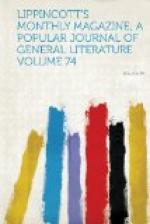What we deem the fruit of the fig is, it will be remembered, only the husk, the apparent seeds being the true fruit and—before ripening—the blossom. A small fly establishes itself in the interior of the wild fig, escaping in great numbers when the fruit is ripe. This happens before the ripening of the improved fig, and the fly is supposed to carry the wild pollen to the flowers of the latter. A single insect, say the Kabyles, will perfect ninety-nine figs, the hundredth becoming its tomb. Some varieties of figs do not need caprification, but they are said to be unsuitable for drying or shipment.
The Italian practice of touching the eye of each fig, while yet on the tree, with a drop of olive oil seems opposed to the African plan; since the oil would certainly exclude the insect. And there are no better figs in the world than those of the Southern States of the Union, which are not treated in either way, and receive the least possible cultivation of any kind. Those States, if it be true that the difference in the yield of a “caprified” and non-caprified tree is that between two hundred and eighty and twenty-five pounds, cannot do better than borrow a leaf from the Kabyle book, should it only be a fig-leaf to aid in clothing the nakedness of bare sands and galled hillsides. The United States Department of Agriculture should by all means introduce the dokhar. Some of our agricultural machinery would be an exchange in the highest degree beneficial to the other side.
[Illustration: The Peak of TIROURDA.]
Long before the French occupation the Kabyles had maintained a regulation which is, we believe, peculiar in Europe to France—the ban, or legally-established day for the beginning of the vintage and the harvest of other fruits. The cultivator may repose under his own vine and fig tree, but he shall not until the word is given by the proper authority put forth his hand to pluck its luscious boon, though perfectly mature or past maturity. Exceptions are made in case of invalids and distinguished guests, and doubtless the hale schoolboy decrees an occasional dispensation in his own favor. The birds share his defiance of the law, and both are abetted by a third group of transgressors, the monkeys.
Africans of this last-named race are in some localities extremely numerous, and they do not restrict their foraging parties to succulent food. Grain is very acceptable to them, and has the advantage of keeping better than fruit, the art of drying which they have not yet mastered any more than the Bushmen or the Pi-Utes. They establish granaries in the crevices of the rocks; and these reserves of provision are sometimes of such magnitude as to make exploring expeditions on the part of the plundered Kabyles quite remunerative.
[Illustration: DJEMA-SAHRIDJ.]




